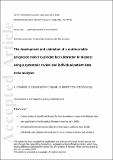Files in this item
The development and validation of a multivariable prognostic model to predict foot ulceration in diabetes using a systematic review and individual patient data meta-analyses
Item metadata
| dc.contributor.author | Crawford, F. | |
| dc.contributor.author | Cezard, G. | |
| dc.contributor.author | Chappell, M. | |
| dc.contributor.author | The PODUS Group | |
| dc.date.accessioned | 2019-10-21T23:36:14Z | |
| dc.date.available | 2019-10-21T23:36:14Z | |
| dc.date.issued | 2018-11 | |
| dc.identifier | 263136329 | |
| dc.identifier | bb018b43-8720-4af2-adba-6c0af887498a | |
| dc.identifier | 85055076920 | |
| dc.identifier | 000447841000003 | |
| dc.identifier.citation | Crawford , F , Cezard , G , Chappell , M & The PODUS Group 2018 , ' The development and validation of a multivariable prognostic model to predict foot ulceration in diabetes using a systematic review and individual patient data meta-analyses ' , Diabetic Medicine , vol. 35 , no. 11 , pp. 1480-1493 . https://doi.org/10.1111/dme.13797 | en |
| dc.identifier.issn | 0742-3071 | |
| dc.identifier.other | crossref: 10.1111/dme.13797 | |
| dc.identifier.other | ORCID: /0000-0002-3011-7416/work/64698148 | |
| dc.identifier.other | ORCID: /0000-0002-0473-9959/work/68281920 | |
| dc.identifier.uri | https://hdl.handle.net/10023/18730 | |
| dc.description | This project was funded by the National Institute for Health Research Health Technology Assessment Programme (project number 10/57/08). Dr M. Monteiro-Soares is supported by Project ‘NORTE-01-0145-FEDER-000016’ (NanoSTIMA), financed by the North Portugal Regional Operational Programme NORTE 2020, under the PORTUGAL 2020 Partnership Agreement, and the European Regional Development Fund (ERDF). | en |
| dc.description.abstract | Aims: Diabetes guidelines recommend screening for the risk of foot ulceration but vary substantially in the underlying evidence base. Our purpose was to derive and validate a prognostic model of independent risk factors for foot ulceration in diabetes using all available individual patient data from cohort studies conducted worldwide. Methods: We conducted a systematic review and meta‐analysis of individual patient data from 10 cohort studies of risk factors in the prediction of foot ulceration in diabetes. Predictors were selected for plausibility, availability and low heterogeneity. Logistic regression produced adjusted odds ratios (ORs) for foot ulceration by ulceration history, monofilament insensitivity, any absent pedal pulse, age, sex and diabetes duration. Results: The 10 studies contained data from 16 385 participants. A history of foot ulceration produced the largest OR [6.59 (95% CI 2.49 to 17.45)], insensitivity to a 10 g monofilament [3.18 (95% CI 2.65 to 3.82)] and any absent pedal pulse [1.97 (95% CI 1.62 to 2.39)] were consistently, independently predictive. Combining three predictors produced sensitivities between 90.0% (95% CI 69.9% to 97.2%) and 95.3% (95% CI 84.5% to 98.7%); the corresponding specificities were between 12.1% (95% CI 8.2% to 17.3%) and 63.9% (95% CI 61.1% to 66.6%). Conclusions: This prognostic model of only three risk factors, a history of foot ulceration, an inability to feel a 10 g monofilament and the absence of any pedal pulse, compares favourably with more complex approaches to foot risk assessment recommended in clinical diabetes guidelines. | |
| dc.format.extent | 2036330 | |
| dc.language.iso | eng | |
| dc.relation.ispartof | Diabetic Medicine | en |
| dc.subject | RA0421 Public health. Hygiene. Preventive Medicine | en |
| dc.subject | 3rd-DAS | en |
| dc.subject | SDG 3 - Good Health and Well-being | en |
| dc.subject.lcc | RA0421 | en |
| dc.title | The development and validation of a multivariable prognostic model to predict foot ulceration in diabetes using a systematic review and individual patient data meta-analyses | en |
| dc.type | Journal article | en |
| dc.contributor.institution | University of St Andrews. School of Medicine | en |
| dc.contributor.institution | University of St Andrews. School of Geography & Sustainable Development | en |
| dc.identifier.doi | https://doi.org/10.1111/dme.13797 | |
| dc.description.status | Peer reviewed | en |
| dc.date.embargoedUntil | 2019-10-22 |
This item appears in the following Collection(s)
Items in the St Andrews Research Repository are protected by copyright, with all rights reserved, unless otherwise indicated.

